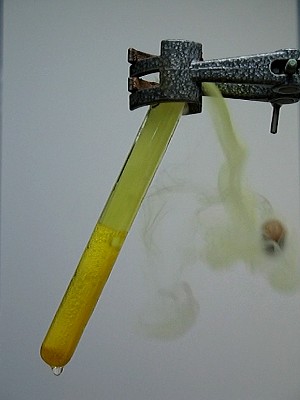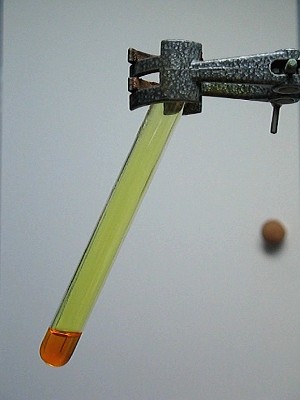


Explosion of chlorine dioxide, triggered by presence of ammonia
This is a very simply, yet impressive experiment. Some chlorine dioxide is made and then a small amount of plain household ammonia is added. Sometimes this leads to a violent explosion, sometimes this leads to a funny whoosh sound and sometimes this just leads to strong fuming.


![]() Chlorine dioxide is a very dangerous compound. It can explode without apparent
reason. Never make more than a test tube full of this gas. This
experiment is safe with the small quantities used in this experiment. Do not
scale up!
Chlorine dioxide is a very dangerous compound. It can explode without apparent
reason. Never make more than a test tube full of this gas. This
experiment is safe with the small quantities used in this experiment. Do not
scale up!
The gas also is fairly toxic, but usually the main reason of its toxicity is the presence of chlorine gas, mixed in with the chlorine dioxide. Pure chlorine dioxide is much less toxic than chlorine gas.
![]()
![]() Required
chemicals:
Required
chemicals:
-
sodium chlorite, but if this is not available, than one can also use sodium chlorate or potassium chlorate
-
concentrated hydrochloric acid (at least 25% HCl) by weight
-
ammonia (5% by weight)
![]() Required
equipment:
Required
equipment:
- robust thick-walled test tubes
- clamp for safely holding test tubes
![]() Safety:
Safety:
- Sodium chlorite is a strong oxidizer. The same is true for sodium chlorate or potassium chlorate. Avoid contact with combustible materials.
- The gas mix, produced in this experiment is toxic, much more so is this the case when chlorate is used instead of chlorite, because when chlorate is used quite some chlorine gas is produced besides chlorine dioxide. Perform the experiment in a well-ventilated area
![]() Disposal:
Disposal:
- All waste, produced in this experiment, can be flushed down the drain with a lot of water. None of the chemicals is particularly toxic for the environment or is broken down quickly.
![]()
Preparation of chlorine dioxide
If sodium chlorite is available then this is the preferred compound to be used for this experiment. It allows making of pure chlorine dioxide without chlorine gas mixed in. This pure chlorine dioxide allows the explosions to be really spectacular.
If no sodium chlorite is available, then sodium chlorate or potassium chlorate can be used. With this, a mix of chlorine dioxide and chlorine can be made. This mix is very toxic due to its chlorine content (much more so than pure chlorine dioxide). With the mix of gases, which can be made from chlorates it still is possible to have an explosion-like behavior, but it will be less powerful.
Making chlorine dioxide from sodium chlorite can best be done as follows:
- Take 250 mg of sodium chlorite and add half a ml of water and dissolve all of the solid in this small amount of water. Add a few more drops of water if not all of the solid dissolves.
- Add half a ml of concentrated hydrochloric acid to this solution. This immediately leads to formation of a lot of chlorine dioxide. This gas has a very strong deep yellow color. Its solution in water is yellow at low concentration and orange at higher concentration.

The pure chlorine dioxide has a peculiar somewhat spicy and rather irritating smell, but it does not have such a strong choking effect as chlorine gas.
Making chlorine dioxide from sodium chlorate or potassium chlorate can be done by adding 200 mg of the solid chlorate to 1 ml of concentrated hydrochloric acid. The gas mix, produced in this way contains roughly 1/3 volume of chlorine and 2/3 volume of chlorine dioxide. The color of the chlorine gas is totally masked by the strong color of the chlorine dioxide. The gas mix, made from chlorate, however has a very strong choking smell due to the chlorine content.
![]()
Explosion of chlorine dioxide
An explosion can be triggered by adding ammonia to the test tube, which contains the chlorine dioxide. Just pour in half to one ml of 5% household ammonia. In most cases this leads to a funny whoosh sound. Sometimes this just leads to strong fuming and sometimes this leads to a rather scary very violent explosion in which most of the liquid is ejected from the test tube. For the latter reason it is important to use a robust test tube with a thick glass wall and to point the test away from people. Three small videos can be downloaded here:
- heavy fuming without sound (download size is 1.1 Mbyte)
- effect with whoosh sound (download size is 2.2 MByte)
- explosion (download size is 2.2 MByte)
![]()
Discussion of results
![]() When sodium chlorite is acidified with a strong acid then the
following reaction occurs:
When sodium chlorite is acidified with a strong acid then the
following reaction occurs:
ClO2– + H+ → HClO2
This chlorous acid is not stable and quickly disproportionates to chloride and chlorine dioxide.
5HClO2 → 4ClO2 + H+ + Cl– + 2H2O
More acid is formed and this accelerates disproportionation of remaining chlorous acid.
The chlorine dioxide escapes from the liquid as a deep yellow gas. Much of it also remains in solution.
![]() The
reaction of chlorate with concentrated hydrochloric acid is very complex. Two possible idealized 'extremes'
can be given for the reaction equation. The
net real reaction will be a
linear combination of these two extremes, resulting in a gaseous mixture of
approximately 50% Cl2 and 50% ClO2 and a higher percentage
of ClO2 in the liquid (this gas dissolves better in water than does
Cl2). The exact ratio cannot easily be determined and depends
on the concentration of the acid and on the temperature. Pure chlorine or pure
chlorine dioxide can, however, never be obtained with the reaction between a
chlorate and hydrochloric acid.
The
reaction of chlorate with concentrated hydrochloric acid is very complex. Two possible idealized 'extremes'
can be given for the reaction equation. The
net real reaction will be a
linear combination of these two extremes, resulting in a gaseous mixture of
approximately 50% Cl2 and 50% ClO2 and a higher percentage
of ClO2 in the liquid (this gas dissolves better in water than does
Cl2). The exact ratio cannot easily be determined and depends
on the concentration of the acid and on the temperature. Pure chlorine or pure
chlorine dioxide can, however, never be obtained with the reaction between a
chlorate and hydrochloric acid.
The two idealized 'extremes' for the reaction equation are.
ClO3– + 5Cl– + 6H+ → 3Cl2(g) + 3H2O
5ClO3– + Cl– + 6H+ → 6ClO2(g) + 3H2O
A reasonable approximation of the net reaction which occurs in reality is:
2ClO3– + 2Cl– + 4H+ → Cl2(g) + 2ClO2(g) + 2H2O
The exact stoichiometry of the reaction, however, can deviate significantly from the last equation, but it always will be a linear combination of the two idealized extremes.
![]() When
ammonia is added to chlorine dioxide, then a reaction occurs, which frequently
triggers the explosive decomposition of chlorine dioxide. Chlorine dioxide
easily decomposes to elementary oxygen and elementary chlorine.
When
ammonia is added to chlorine dioxide, then a reaction occurs, which frequently
triggers the explosive decomposition of chlorine dioxide. Chlorine dioxide
easily decomposes to elementary oxygen and elementary chlorine.